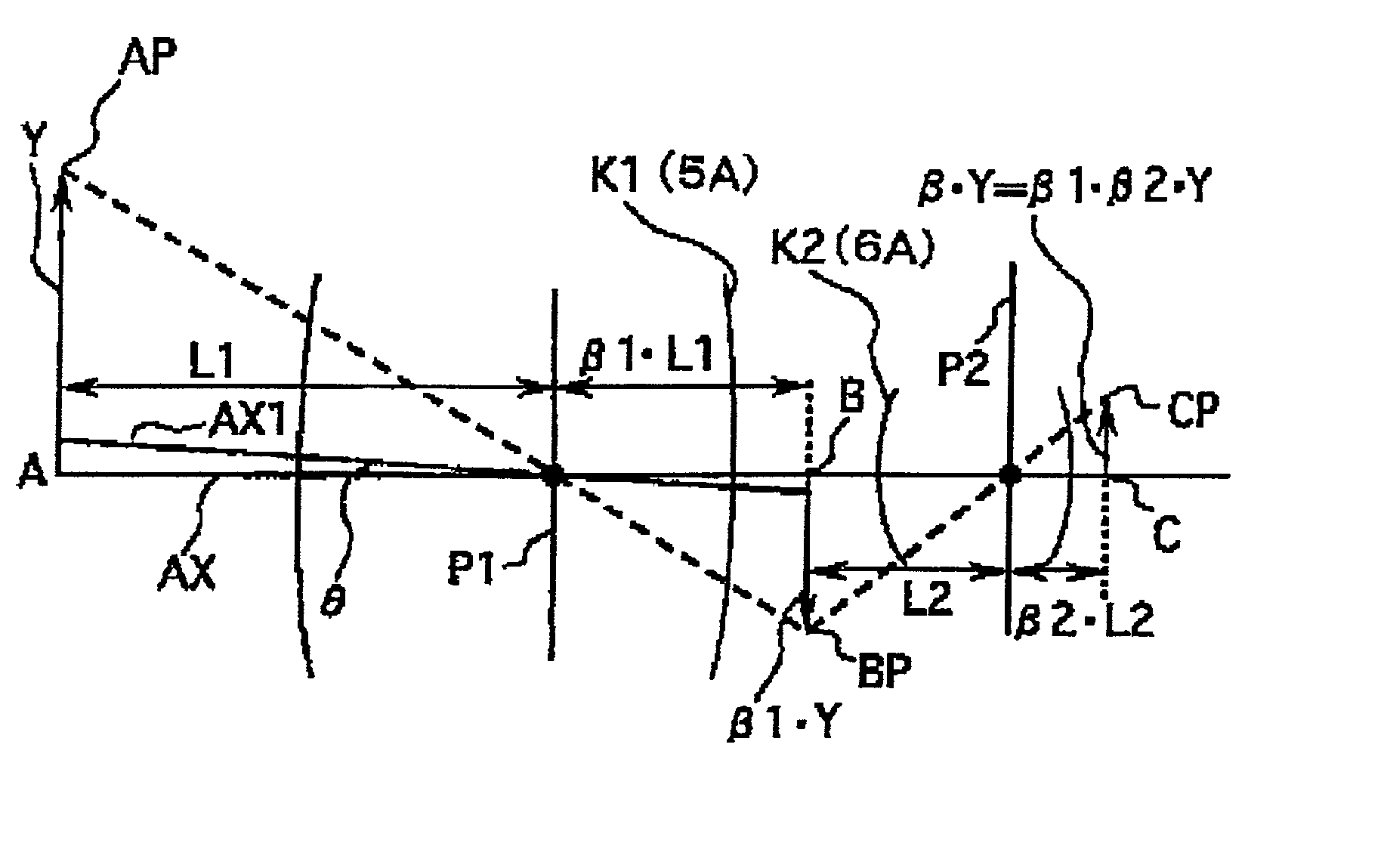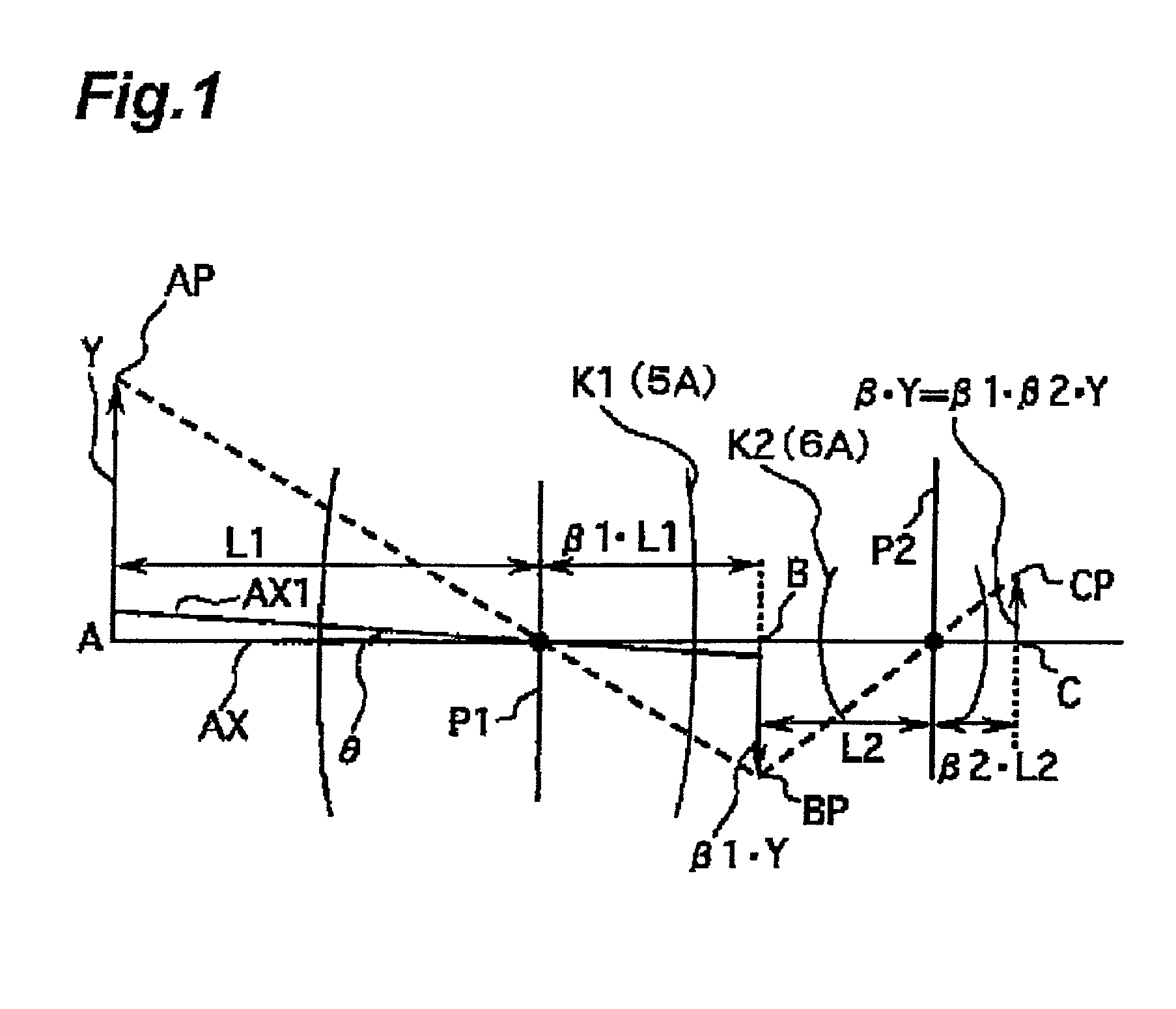Projection optical system, manufacturing method thereof, and projection exposure apparatus
a technology of projection optical system and manufacturing method, applied in the field of projection optical system, can solve the problems of chromatic aberration, limited use of glass materials that can be used under current conditions, and difficulty in putting projection optical system into practical use with a refractive system
- Summary
- Abstract
- Description
- Claims
- Application Information
AI Technical Summary
Benefits of technology
Problems solved by technology
Method used
Image
Examples
first embodiment
[0066] In the following, the present invention is described while referencing FIG. 2 to FIG. 4. This embodiment employs an F.sub.2 laser (center wavelength of 157. 6 nm) as an exposure light illumination light) and is applied to the invention onto an upright cylindrical-shaped catadioptric projection optical system with a reflective mirror that has two apertures respectively formed near the optical axes.
[0067] FIG. 2 is a lens block diagram of a projection optical system according to this embodiment. In FIG. 2, an image of an object disposed in object plane 1 first plane) is formed on image plane 4 (second plane) by the projection optical system of this embodiment with a predetermined projection magnification .beta. (lateral magnification). Projection magnification .beta. of this embodiment is 1 / 4.times.. During exposure, the pattern surface of the reticle R, which is used as a mask, is disposed in the object plane, and the surface of the wafer W (glass plate, etc.), which is used a...
second embodiment
[SECOND EMBODIMENT]
[0102] Next, a projection optical system according to the second embodiment of the present invention is described while referencing FIG. 1 and FIGS. 5 to 7. This embodiment employs an F.sub.2 laser (central wavelength of 157.6 nm) as the exposure light and is used in the present invention onto an upright cylindrical catadioptric projection optical system including two reflective mirrors, the respective apertures thereof formed along each of the two optical axes. In FIGS. 5 to 7, the portions corresponding to those of FIGS. 2 and 3, are assigned the same or similar reference mark and their detailed description is omitted.
[0103] FIG. 1 is a schematic view of the projection optical system of this second embodiment. In FIG. 1; the projection optical system of this embodiment comprises a first imaging optical system K1 and a second imaging optical system K2; wherein a light from object point AP, which is located at height Y of a position A on an optical axis AX, passes...
third embodiment
[THIRD EMBODIMENT]
[0127] The third embodiment of the projection optical system according to the present invention is described using FIGS. 8 and 9. In the third embodiment, the present invention is applied to the off-axis catadioptric type (a light passes through the outside of the predetermined reflecting mirror) projection optical system, which uses the ArF excimer laser (central wavelength: 193.3 nm) is used as the exposure light. For the parts in FIGS. 8 and 9 corresponding to the parts in FIGS. 2 through 6, the same or similar reference numerals and detailed descriptions are omitted.
[0128] FIG. 8 is a block diagram of the lens of the catadioptric type projection optical system in this embodiment. In FIG. 8, the projection optical system of this embodiment comprises: a catadioptric type first imaging optical system G1, which forms intermediate image I1 of reticle R pattern on the object plane (the first plane); and dioptric type second imaging optical system G2, which forms the ...
PUM
| Property | Measurement | Unit |
|---|---|---|
| wavelengths | aaaaa | aaaaa |
| wavelengths | aaaaa | aaaaa |
| wavelength | aaaaa | aaaaa |
Abstract
Description
Claims
Application Information
 Login to View More
Login to View More - R&D
- Intellectual Property
- Life Sciences
- Materials
- Tech Scout
- Unparalleled Data Quality
- Higher Quality Content
- 60% Fewer Hallucinations
Browse by: Latest US Patents, China's latest patents, Technical Efficacy Thesaurus, Application Domain, Technology Topic, Popular Technical Reports.
© 2025 PatSnap. All rights reserved.Legal|Privacy policy|Modern Slavery Act Transparency Statement|Sitemap|About US| Contact US: help@patsnap.com



